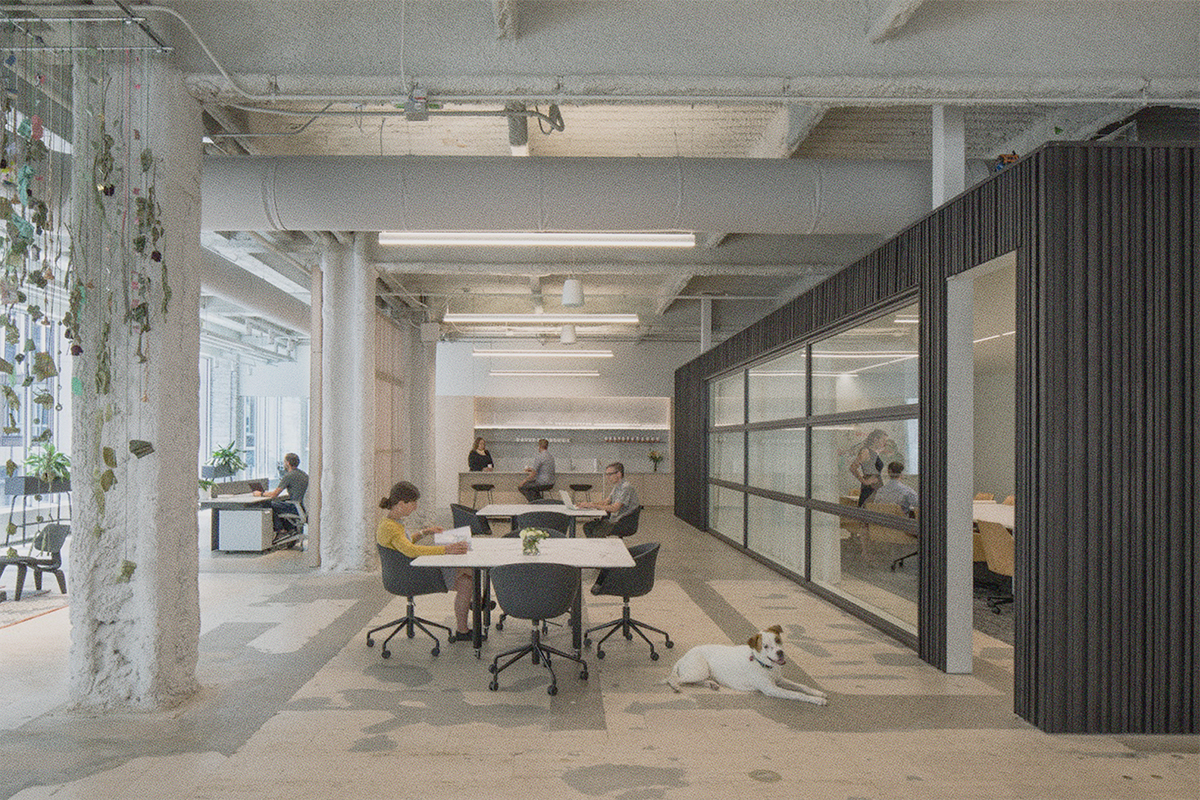 Policy Brief + Recommendations
Policy Brief + RecommendationsThis episode featured Teresa McGrath, the Chief Research Officer for Habitable.
She digs into the environmental implications of paint components and offers scientific insights on sustainable alternatives. Some of her suggestions are even trending—popular wall treatments such as Limewash and Roman clay are healthier alternatives.

A path towards planetary health is more urgently needed now than ever, but our current materials economy creates rampant pollution, climate change, and growing inequity. Shifting from harmful practices to healthful solutions will require cross-sector partnerships, holistic thinking, and exciting new approaches that reduce the burden of industry on people and our planet.
Watch Habitable’s special Earth Month webinar featuring leading global voices, including:
- Dr. Bethanie Carney-Almroth
- Dr. Veena Singla
- Martha Lewis
Moderated by Gina Ciganik, CEO of Habitable
The Resource Efficiency Collective at Cambridge University explores how to deliver future energy and material services while reducing resource use and environmental impact, aiming to find suitable metrics and solutions for a more resource-efficient society.

Overwhelming evidence suggests our health and well-being are significantly impacted by the conditions in the environment where we are born, live, learn, work, and play, with some suggesting that our zip codes are better predictors of health than our genetic code.
Also referred to as social determinants of health , these conditions range from access to and quality of education, transport, and health care services to housing conditions and the toxics and pollutants we are exposed to in the neighborhoods we live in.
While definitions may vary around what these conditions are and which should be prioritized, there is general consensus that:
- These conditions exist because of decision-making processes, policies, structures, and practices designed and implemented by humans;
- These conditions create inequities in health, disproportionately impacting low-income families, families living with incomes below the federal poverty level, and people of color, and;
- Cross-sector collaboration is needed to deliver the highest standards of health for all, with special attention given to the needs of those who are at greatest risk.

In alignment with efforts tackling the root causes of health inequities, Healthy Building Network (HBN) entered into a partnership with United Renters for Justice (IX), a nonprofit working to transform the Minneapolis housing system, to reduce tenant exposures to toxic chemicals used in building products. Funded through an Environmental Assistance grant by the Minnesota Pollution Control Agency (MPCA), this collaborative project prioritized toxic exposure reduction in areas designated to be of environmental justice (EJ) concern by the MPCA. EJ concern areas include tribal land and census tracts with higher concentrations of low-income residents and people of color – communities that are disproportionately impacted by toxic chemical exposures and other forms of pollution.
This collaboration provided the unique opportunity to embrace the perspective of tenants in the co-creation of resources to help them make informed decisions about the products used in their housing units and common areas. Specifically, this meant designing resources that would leverage IX’s organization and mobilization skills as well as the structure of a recently established tenant cooperative, “A Sky Without Limits.” Also, it meant increasing information accessibility, for example, through the use of non-technical language and making the resources available in both English and Spanish.
Tenant organizations and other stakeholders can access HBN’s healthier building product guidance at informed.habitablefuture.org and by watching this 10-minute seminar video:
Watch the Seminar (English)
Ver el Seminario (Español)
This high-level, 10-minute recording can be used to educate the general public (e.g., tenant meetings) about the importance of avoiding toxic products. It begins by breaking down myths and misconceptions around the perceived hazards and safety of natural and synthetic chemicals and discusses how toxic products impact individuals and families, especially children, along the lifecycle of products.
By empowering the people most affected by toxic chemical exposures to advocate for and create change in their living conditions, this project creates avenues for creating a safer environment for all. Anyone who influences product purchasing decisions – including manufacturers, building owners, managers, developers, architects, investors, policy makers, and consumers – has the power and responsibility to reduce health inequities for those using or exposed to those products every day. This includes residents, workers, installers, and the communities that surround the facilities where these materials are processed and disposed of. By making material health a priority in your decision-making processes, you’ll be joining efforts to tackle the root causes of health inequities in communities around the world. Visit informed.habitablefuture.org to learn how our building product guidance can help you make better material choices.

Simona Fischer, MSR Design
As registered architect, sustainable design professional, and associate with MSR Design, Simona Fischer has spent much of her career thus far developing and testing strategies for integrating sustainable design into the workflow of architectural practice. Her experience includes project management, Living Building Challenge documentation, and firmwide sustainable design implementation.
Simona is a dynamic community of practitioners who help co-create solutions to accelerate the adoption of healthier building materials in affordable housing. She has presented at national conferences, lectures regularly at the University of Minnesota, and currently co-chairs the AIA Minnesota Committee on the Environment (COTE).
Simona was instrumental in the Living Building Challenge Petal Certification of MSR Design’s new downtown Minneapolis headquarters, which achieved the materials, beauty, and equity petals. The project incorporated more than 114 Red List Free materials and achieved a 28 percent reduction of its embodied carbon footprint by using salvaged materials. She also led the development of guidelines around transparency, sustainability, and health for the firm’s materials library, including training materials for staff and external sales reps.
We sat down with Simona to learn why materials have been a focus of her career and to get her perspective on the green building industry today.

What sparked your passion about healthier materials? Was there an “aha” moment or a time that something just clicked?
I was that kid who won a prize for designing the elementary school recycling banner, so I guess I’ve cared about materials for a long time. But my interest in building materials was piqued in architecture school, when we were challenged to create a new ecolabel. Faced with inventing a way to compare one material to another in terms of sustainability, I realized how mind-blowingly complex of a task that was. How do you make the criteria objective? How do you compare products across categories? How do you measure health – is it just by the list of ingredients, or do you include research on health outcomes factoring exposure and risk (and if so, what research even exists)? How do you stack human health and other metrics against each other and choose which factor outweighs the other? How do you account for performance and durability? The questions were endless and led to more questions, which I found complex and intriguing. In other topic areas like water and energy in buildings, the goal seemed straightforward (at least on the surface). Use less energy, and make it cleaner. Use less water, and make it cleaner. But with materials, the number of variables were infinite. We had to think about balancing not just toxicity to people and embodied carbon, but also harvesting of raw materials, ethical manufacturing, and what to do with all that stuff at the end of its useful life.
I ended up writing my MS thesis on methods for assessing sustainability at the level of the manufacturer, as opposed to focusing solely on individual products which change so frequently. I was really just trying to find a system map at a higher level, and make the big, shifting world of materials more manageable in my head. I still use some of what I learned during that project as indicators of whether a building product manufacturer is serious about human health and sustainability, or just greenwashing. But sometimes they are greenwashing because they don’t know any better, and they are on their way to improving. So you can’t just write off smaller companies who don’t yet have all the documentation. It’s a learning process for them as well.
At MSR Design, the conversation about healthy materials had already started when I joined to work on The Rose, a Living Building-inspired affordable housing development in Minneapolis. My colleagues Rhys MacPherson, Paul Mellblom, and Rachelle Schoessler-Lynn were leading the conversation about why we should, and how we could, avoid vinyl and other chemicals on The Rose and on other projects across the firm. Over the next couple years we held a number of all-staff discussions and training sessions on healthy materials. Many staff members, from seasoned designers to interns, became interested in the question of how we could do better while still delivering a beautiful aesthetic and the best functionality for our clients. By the time we were ready to start designing our new studio, healthy materials as a concept had had enough time to become embedded in the culture
Tell us about your project to build the new MSR studio. Why was it important to prioritize healthy materials for this project? What went into your process?
When we knew we were moving, we held an all-staff discussion to debate frameworks for certification. We considered LEED, WELL, Fitwell, and Living Building Challenge Petal Certification. In the end, LBC won, because the Materials Petal was so ambitious, prioritizing not only human health through the use of Red List Free products, but also environmental health and other butterfly-effect impacts of resource harvesting and global warming potential and waste. At the same time, the LBC path included an emphasis on equity, as well as using the project as a tool to educate and inspire others. We found the holistic approach inspiring, and appreciated the challenge (most days).
It was important to prioritize healthy materials because we knew our staff cared about living out our values around healthy indoor environments. I think the team will agree that meeting the Red List requirement was difficult. It took time to develop a workflow for gathering the documentation. But it also gave us the opportunity to rethink the way we approach materials from the start of projects. Instead of trying to weed out all the “bad” chemistry, we found it was actually easier to start from scratch and build up a list of materials we knew were likely to comply with the requirement. It ended up being simpler, mostly natural materials, which we used as the palette for our space.
How do you consider low embodied carbon versus health in product selection?
Non-toxic materials and low embodied carbon are two lenses on a singular problem, which is planetary health. Human health is a subcategory of planetary health, since we’re part of the planet and made of its stuff. When indoor and outdoor environments, and plant and animal and human bodies, are polluted by toxic substances, both from human-made toxins and an overabundance of greenhouse gasses, the global ecosystem suffers and humans suffer within it. We are nature. What’s interesting is, younger, upcoming professionals and design students seem to understand this intuitively. They don’t even need to be told that human and global environmental health go hand in hand. So I think as an industry, we just need to accept the interplay of embodied carbon and human health as a foregone conclusion and get straight to the nitty-gritty of what materials we use and how those materials are grown, produced, manufactured and delivered.
That said, we also need to get serious about the data used to back up carbon and health claims. We need transparent, standardized reporting from manufacturers, including making sure the scope of every life cycle assessment (LCA) takes all the impact categories of the AIA Materials Pledge into account. I think petroleum-based building materials are going to be a battleground for a while to come. The low purchase price and saturation in the market make plastics seem like an easy choice for all kinds of different finishes and performance layers in buildings. It is possible to make them somewhat healthier for end-users by being careful to avoid certain additives. But that leaves a massive loophole; the impacts of production and waste on planetary health. I think there’s an opportunity for data to drive a new understanding here. If we can start seeing standardized collection and data crunching of environmental product declaration (EPD) data from different product sectors, we might be able to correlate carbon from building products more directly to regional health impacts of the production of those chemistries. This would help close loopholes that allow the incredible health impact of high global warming potential (GWP) emissions to stay hidden in the shadows
How have you used your knowledge to help move your clients toward healthier materials? What has been most successful?
I think some of my most successful work has been in addressing priorities and processes in our workflow. I can’t count the number of times I’ve heard people say they just wish there was a single, simple database of all the great products. There are ever-improving databases out there, but people always want something else that is missing, so the problem hasn’t been solved. I think the missing piece is a deeper understanding of the principles of product categories, such as knowing what different types–not brands, but general types–of insulation or countertop materials are made of, and where they come from. This level of knowledge, over time, becomes a kind of intuition one uses to filter the world of products even as new things constantly appear in your inbox or your lunch and learns. When you understand the principles, and don’t just rely on a database to provide a solution, it also gets easier to speak knowledgeably and make solid recommendations to clients.
On project work, I have the best luck when I’m upfront about why we need to consider material health alongside cost. You have to tailor your message to the audience, for example, some clients are most receptive to the idea of improving their impact on the world, whereas for others, the message that hits home is one of directly affecting their health or the health of people they care about
How has Habitable’s InformedTM building product research been helpful or influential?
I love InformedTMand recommend it to designers all the time, and clients too. The information is organized in terms of product categories as opposed to brand names or labels, so it aligns with the level of learning that I think is most beneficial to becoming smarter in practice. We used the sample specs to rewrite our paint specifications in 2021. We’ve also heard great lectures from Habitable research team members over the years that have left an impact on our staff.
What advice do you have for other AEC leaders? Are there processes or approaches you would recommend? Where would you recommend a newcomer to healthier materials start?
For designers, I recommend signing the AIA Materials Pledge and studying the categories. The Pledge is a great framework – if you address each of the Pledge categories in some way, you know you’re hitting the right bases. If you can, allot some time to staff education and discussion. I recommend the Living Building Challenge Materials Petal as a particularly inspiring framework for education and good discussion, because it is based on absolute goals, instead of relative improvement. The COTE Super Spreadsheet (downloadable on the AIA website) is a good starting point for addressing materials issues in an applied manner on projects.
At MSR Design, our internal education efforts led to the development of our Material Library Entry Criteria. If others want to design similar criteria for their libraries, they are welcome to copy ours outright or modify as needed: www.msrdesign.com/generative-impacts.
The more we as designers align in our message to manufacturers about health and carbon, the easier it becomes for them to stay in business while giving us what we want
What are you most excited about right now?
I’m excited about natural and biobased materials. On the high-tech side, there is so much opportunity for new materials to be developed, especially bio-based polymers. On the other hand, there is a new straw bale project that is being built in Minneapolis. It’s low tech in comparison to the latest research in biomaterials, and yet it combines healthy, natural materials seamlessly with low carbon construction. The team is using Passive House building science principles to build a durable system, which they will test with sensors in the walls over the next few years. I really resonate with the idea that we can build a sustainable future with natural materials in both high- and low-tech ways
What do you want other people to know?
We, as an industry, are practicing architecture and construction in an era where buildings are made of hybrid material systems so complex, we hardly know what’s in them or why they work. I think we architects can perhaps find evidence of the Vitruvian virtues of utilitas (utility) and venustas (beauty) in the work we produce, but somewhere as a profession, I think we have let go of the firmitas (stability). Not in the sense of solid structure, but in the sense of owning materiality and material knowledge as a critical aspect of an architect’s role. We have become accustomed to accepting a level of vagueness about assemblies and their tons of little components, and leaving the details to the product manufacturer. I think understanding materials deeply is about reclaiming this knowledge, and a piece of architecture we have lost
Thank you to Simona and MSR design for being leaders in healthier materials! To learn more about the MSR headquarters project, check out this case study. You can also learn more about MSR’s commitment to sustainable design and download their Sustainable Materials Action Packet on their website. Follow this link to learn more about InformedTM, product guidance which Simona mentions influencing her practice.
Symptoms of “sick building” syndrome include “headache; eye, nose, or throat irritation; dry cough; dry or itchy skin; dizziness and nausea; difficulty in concentrating; fatigue; and sensitivity to odors”.1
These symptoms can develop after long-term exposures, or they can occur after a single instance of exposure, as in the case reported by the Minnesota Daily last month.2 Three carpet installers were sent to the emergency room after installing carpeting in an apartment building intended for student housing near the University of Minnesota. The workers could not tell doctors what they were exposed to because the carpeting did not include a complete list of contents. To find out, the workers first measured the air quality with a device ordered off of Amazon, which immediately “jumped to red” when exposed to the carpeting. The Minneapolis Building and Construction Trade Council then sent carpet samples to a lab for emissions testing. This testing found total volatile organic compounds (TVOCs) at levels that “significantly exceed” typical levels in the air. The chemicals noted on the report included some on the Minnesota Department of Health list of Chemicals of High Concern.3
What we know is that there is no law or regulation that requires building product manufacturers to disclose all product content. One of the workers interviewed for the report said he has persistent symptoms including impaired memory function, ringing in his ears, and fatigue. Because current regulations will not protect consumers, workers, or building occupants from toxic chemicals in building products, it is up to building owners, designers, specifiers, architects, other AEC professionals to know better, so we can do better. This story highlights the need for full disclosure of building materials. Until that becomes the norm, use our InformedTM product guidance to identify building products–like carpet–that are healthier for people and our planet.

After ventilating the student housing building in Minneapolis, the city’s initially “high chemical readings” dropped. According to the Minnesota Daily article, the city’s inspections show the levels are now safe. Meanwhile, one of the workers who was initially sickened by the incident was an independent contractor and therefore ineligible for workers’ compensation for the symptoms he is still experiencing months later. This and future incidents are preventable. Safer selection of materials begins with product transparency.
SOURCES
- EPA, 1991.Air and Radiation (6609J). “Indoor Air Facts No.4: Sick Building Syndrome” Factsheet” (https://www.epa.gov/sites/production/files/2014-08/documents/sick_building_factsheet.pdf)
- MN Daily. 2019. “Chemical analysis finds potential health risks for former workers at the arrow” (https://mndaily.com/201203/news/ftprimeplace2/)
- chemicals found in testing of the carpet as cited in the MN Daily report included: ethyl hexanol and multicomponent solvents: “possibly naphtha, Stoddard solvent or petroleum distillate”. Naphtha, also known as Stoddard solvent is MDH chemical of high concern.

Global industry has made progress toward a world in which more efficient use of resources, including recycling, helps to reduce impacts on the natural systems that support life. However, contamination of recycled-content raw material with potentially toxic substances reduces feedstock value, impedes growth of recycling rates, and can endanger human and environmental health.
This paper provides findings and recommendations about how progress in resource use efficiency and recycling can occur along with the production of healthier building products. This paper is based on the review of eleven common recycled-content feedstocks used to manufacture building materials that are sold in California’s San Francisco Bay Area. It provides manufacturers and purchasers of building products, government agencies, and the recycling industry with recommendations for optimizing recycled-content feedstocks in building products to increase their value, marketability and safety.

Asthma rates in the United States have been rising since at least 1980. Today, nearly 26 million people are affected by chronic asthma, including over eight million children. These rates are rising despite the proliferation of asthma control strategies, including indoor air quality pro- grams. The Centers for Disease Control (CDC) reported that the number of people diagnosed with asthma grew by 4.3 million during the last decade from 2001 to 2009.
As asthma affects more people, it becomes increasingly clear that new strategies need to be considered, focusing on the prevention of asthma onset. Few strategies are in place that effectively prevents exposure to chemi- cals that cause asthma. Due to the complexity of this condition conventional efforts have largely focused on asthma management. Health organizations have identified a number of chemicals that are known to cause the onset of asthma, and are therefore labeled asthmagens. Since these chemicals are common ingredients of many interior finishes, like floors, carpets, and paints, it is possible to improve asthma prevention strategies by reducing or eliminating these chemicals from building materials. The Healthy Building Network (HBN) took a three-pronged approach that examined how pervasive asthmagen chemicals are in the built environment, what steps have been taken to address them, and what further actions are needed.

Arlene Blum is a biophysical chemist, author and mountaineer.
She is the founder and executive director of the Green Science Policy Institute which works with scientists, government, industry, and non-profits to facilitate more informed decision-making about flame retardants and other chemicals used in consumer and building products.
Healthy Building Network founder Director Bill Walsh caught up with Elaine, recording the following conversation:
Bill Walsh:
How did you get started working on flame retardants?
Arlene Blum:
Thirty years ago, as a researcher at the University of California, Berkeley, I published a paper in Science magazine showing that “Tris” flame retardants in children’s sleepwear caused mutations, were possible cancer hazards, and migrated from pajamas into children. The flame retardants were removed from children’s sleepwear in 1977, but chlorinated tris is now back in use in foam in furniture and other products.
BW:
Why are you so concerned about flame retardants in building materials?
AB:
If a building contains halogenated flame retardants in the insulation, they can filter into the building throughout its life and also form toxic dioxins if the building burns.
I know it’s a real dilemma for people when they learn that plastic insulation materials, such as polystyrene, polyisocyanurate, and polyurethane, that can help reduce climate change, often contain flame retardants which can cause serious health and environmental harm. But the good news is that this is a problem that can be solved.
Once green building professionals understand the issue, they can move to safer substitutes and strategies that don’t have potential adverse health impacts. In fact of the various groups with which I’ve worked on reducing toxics in products, the green building community has been the most responsive. So I am very happy to have the opportunity to share the message about moving away from the use of halogenated flame retardants at Greenbuild.
The new LEED Pilot Credit on Chemical Avoidance for not using phthalates and halogenated flame retardants inside buildings should accelerate our progress towards healthier buildings.
BW:
You mentioned that this is also a chemical contamination problem that could have negative impacts on our health and well-being at a global level? How?
AB:
Many halogenated flame retardant chemicals are persistent and bioaccumulate especially in humans and animals high on the food chain. It is almost impossible to clean them up once they are out in the world. For example, PCBs, chlorinated chemicals that were also used as flame retardants, were banned in 1977, but very high concentrations can still be found in wildlife and some human populations today. Studies show that human breast milk contains flame retardants, and toddlers have three to four times higher body levels than their mothers.
When tested in animals, many halogenated flame retardants have been found to cause health problems like cancer, reduced fertility and IQ, thyroid disorders, and developmental impairment. Many halogenated flame retardants are also endocrine disrupting chemicals that can harm us at very low concentrations.
BW:
How do you weigh the known benefits today against long term unproven risks?
AB:
In furniture there is no proven benefit. It makes more sense to reduce the sources of ignition with fire-safe cigarettes and candles than to put potentially toxic chemicals in all the possibly flammable materials in our homes. Today the risk of home fires is diminishing due to a 50% decrease in cigarette consumption since 1980, enforcement of improved building, fire, and electrical codes, increased use of sprinklers and smoke detectors. These strategies provide measurable improvements in fire safety without toxicity.
Smoke and toxic gases kill people in fires, more than flames. Research on furniture fires show that while halogenated flame retardants can reduce the time for ignition by seconds, they greatly increase the carbon monoxide, smoke, and soot. The chemicals also release dioxin and related compounds when burned at relatively low temperatures. So the benefits of retarding the fire with toxic chemicals is greatly reduced by the increased fire toxicity and dioxins at the fire scene.
Given the lack of proven benefit in some cases, the risk-benefit calculation on chemical flame retardants can be tenuous even before you start to consider the widespread exposure to these chemicals on a daily basis.
Better methods of reducing fire risks include careful material selection and alternative fire suppression strategies that can be designed into products and buildings.
BW:
How can people take this knowledge and translate it into action?
AB:
When people know about the hazards of the flame retardants that are commonly used in many plastic foam insulations, furnishings and other building materials, they can choose alternative products or push for less toxic flame retardants. When green building professionals make these choices, this will increase the availability and decrease the cost of the alternatives.

Moving the market demand for flame retardants in the huge building sector can also help with policy changes. We have been providing scientific support to change a California furniture flammability standard to provide similar or greater fire safety without flame retardant chemicals.
We also need national chemical policy reform. Because of weaknesses in the Toxic Substances Control Act, which has not been updated since 1976, chemicals are innocent until proven guilty and that proof is almost impossible to obtain. Even asbestos could not be banned. And manufacturers are not required to perform any toxicity tests before putting chemicals into products! Green buildings need to be both energy-efficient and healthy. Reducing the use of halogenated flame retardants will help achieve this and help create a healthier world for us all.
…that some building products may expose you to the chemical banned from plastic bottles?
Everyone has heard the news about the health concerns associated with bisphenol A (BPA) leaching from baby bottles, food can liners and perhaps most famously those distinctive polycarbonate plastic water bottles popularized by Nalgene.[1] Last May, Chicago became the first city in the U.S. to ban the sale of baby bottles and sippy cups made from BPA. Few, however, are aware that BPA is a chemical component of epoxy resins used in a wide range of building materials, typically paints, sealants, adhesives and fillers,[2] that may put manufacturing workers, installers, and building occupants at risk.
Epoxy resins are used in building materials, often listed on a material safety data sheet as a proprietary mixture, without disclosure that the resin is made from BPA. While manufacturers claim that the BPA in epoxy resins is consumed entirely in the production process and does not show up in the final products, scientists investigating the metabolic breakdown of epoxy resins during occupational exposure have found that epoxy resin products can be metabolized in the human body back into BPA and may impact the endocrine and reproductive system of those exposed.[3]Animal studies have linked this hormone-disrupting chemical to prostate cancer, breast cancer, pre-diabetes (insulin resistance), abnormal fat metabolism, early puberty, and changes in the way the brain develops resulting in behavioral abnormalities.[4]
The BPA expert panel from the Center for Evaluation of Human Risks to Reproduction raised concern about BPA in epoxy-based resins, reporting to the National Toxicology Program that, “several studies collectively suggest hormonal effects of bisphenol A exposure, including one in occupationally exposed male workers likely exposed through multiple routes including inhalation…”[5] The NTP’s final monograph states that “a number of studies, when considered together, suggest a possible effect on reproductive hormones, especially in men exposed to higher levels of bisphenol A in the workplace.”[6] Germany has already instituted occupational exposure limits for bisphenol A.[7]


Recent biomonitoring studies have raised concerns about widespread human exposure to BPA. A National Health and Nutrition Examination Survey (NHANES) study found that more than 90% of people in a representative sample of the general population have BPA residues in their urine[8] and that there must be significant non-food exposures to reach such levels.[9]
It is likely that BPA in building products will become subject to greater health and safety regulation, but responsible specifiers do not need to wait for the regulatory system to catch up with the science to protect their clients. Products are available that can replace epoxy-based coatings and adhesives. For example, many paint companies now offer high-performance low-VOC water-based acrylic paints and acrylic-based adhesives for flooring, carpets, and wall covering. For applications where high-performance BPA-free substitutes are not yet available, the act of asking manufacturer reps for products without bisphenol A is an important step to prod the industry to bring safer high performance alternatives to market.
For a comprehensive discussion of the emerging science on BPA risks, read “Bisphenol A in Building Materials: High Performance Paint Coatings.”
SOURCES
- BPA is also known as a component of dental sealants, some medical and dental devices, and thermal paper receipts.
- Epoxy-based products are used in a wide range of applications including coatings (such as paints, floor sealers and protective coatings), adhesives and fillers (including caulks, grouts, mortars, and putties), fiberglass binders and cement additives. Epoxy resins are also in some wind energy applications, generators and other electronic equipment, industrial tooling applications, and materials used in the art, aerospace and marine industries.
- Hanaoka T, Kawamura N, Hara K, Tsugane S. Urinary bisphenol A and plasma hormone solvents in male workers exposed to bisphenol A diglycidyl ether and mixed organic solvents. Occupational and Environmental Medicine, 2002; 59:626; Cha B, Koh S, Park J, et. al. Influence of Occupational Exposure to Bisphenol A on the Sex Hormones of Male Epoxy Resin Painters. Mol Cell Toxicol. 2008; 4(3): 230-234.
- Sarah Janssen, staff scientist for the NRDC, summarizes health concerns and the issue with links to some of the key science on her 7/13/09 blog entry “California is the latest battleground on BPA regulation”. http://switchboard.nrdc.org/blogs/sjanssen/many_of_my_blog_posts.html.
- Expert Panel cited in NTP-CERHR Monograph on the Potential Human Reproductive and Developmental Effects of Bisphenol A page 15. http://cerhr.niehs.nih.gov/chemicals/bisphenol/bisphenol.pdf.
- Ibid at page 37.
- Murakami T, Oyama T, Isse T, et al. International comparison of criteria for evaluating sensitization of PRTR-designated chemical substances. Environmental Health and Preventive Medicine 2007;12:56–65, citing Deutsche Forschungsgemeinshaft. List of MAK and BAT Values 2004, Commission for the investigation of health hazards of chemical compounds in the work area, Report No. 40. Weinheim: Wiley-VCH Verlag GmbH & Co. KGaA; 2004.
- Calafat A., et. al., Urinary concentrations of bisphenol A and 4-nonylphenol in a human reference population. Environ. Health Persp. 2005; 113(4): 391-395. http://www.ehponline.org/members/2004/7534/7534.html. Accessed online June 20, 2009.
- Stahlhut R, Welshons W, Swann S. Bisphenol A data in NHANES suggest longer than expected half-Life, substantial nonfood exposure, or both. Environ Health Perspect. (2009); 117(5):784-789. http://www.ehponline.org/docs/2009/0800376/abstract.html. Accessed online July 20, 2009.

 Health
Health Pollution
Pollution Climate Change
Climate Change Equity
Equity